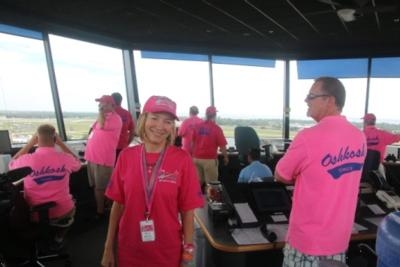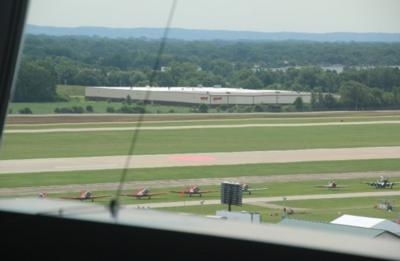Tue, Jul 21, 2015
KOSH - Busiest Airport Control Tower In The World ... At Least This Week
By Bruce Brandon
The relatively sleepy KOSH tower ... which is normally a contract tower ... for one week leads the world in aircraft movement when measured in operations/hour. Depending on the year, there have been up to 20,000 aircraft movements during AirVenture. This, for an airport that is only open between the hours of 0600 and 2000, or 14 hours. As one would imagine, to accomplish this safely is a mammoth undertaking. For AirVenture, the FAA sends in a team of 86 personnel to support and staff the tower. Ms. Elaine Buckner, a 16 year ATC veteran of AirVenture, is the FAA’s head honcho (aka tower manager).

The FAA’s personnel come primarily for the central region of the U.S. although it is possible for others to be selected. Ms. Buckner’s normal job is that of Tower Manager at Minneapolis/St. Paul airport (KMSP).
FAA’s selection of controllers for this two week assignment is done by a bidding process that includes ensuring that there are both experienced as well as relatively new controllers are selected. The majority of controllers selected continually return so that there is institutional knowledge of how to make this controlled chaos safe.
The system is amazingly complex yet simple. It is done under VFR, with spacing beginning approximately 10 NM SW of KOSH. When passing over a VFR point know as FISK one of the four FAA controllers will identify an aircraft by color and issue a runway assignment. If the instructions are understood, no response is to be made.

KOSH tower is manned by two four person teams. This gives extraordinary oversight of the steady arrival of aircraft which in turn allows the normal minimum landing distance between aircraft to be reduced from 3,000 ft. to 1,500. This means that there are multiple touchdown zones on the runways that are identified by large colored circles. Pilots are instructed to land referencing these colored circles (see picture).
ATC even accommodates aircraft that don’t have radios, of course priori coordination is required. Note to pilot, refresh your understanding of tower light signals. Clearance to land is given with lights.
One thing is certain when landing at AirVenture. You will fully understand why your flight instructor always said to keep you head on a swivel. And remember, if flying in to AirVenture, it is imperative that you check NOTAMS!!!
(Staff Images)
More News
Aero Linx: Model Aeronautical Association of Australia MAAA clubs are about fun flying, camaraderie and community. For over 75 years, the MAAA has been Australia’s largest fl>[...]
Touchdown Zone Lighting Two rows of transverse light bars located symmetrically about the runway centerline normally at 100 foot intervals. The basic system extends 3,000 feet alon>[...]
“Discovery and innovation are central to our mission at Virgin Galactic. We’re excited to build on our successful record of facilitating scientific experiments in subor>[...]
How To Get A Story On Aero-TV News/Feature Programming How do I submit a story idea or lead to Aero-TV? If you would like to submit a story idea or lead, please contact Jim Campbel>[...]
Student Pilot Reported That During Rotation, “All Of A Sudden The Back Of The Plane Kicked To The Right..." Analysis: The student pilot reported that during rotation, “>[...]
 ANN's Daily Aero-Linx (05.02.24)
ANN's Daily Aero-Linx (05.02.24) ANN's Daily Aero-Term (05.02.24): Touchdown Zone Lighting
ANN's Daily Aero-Term (05.02.24): Touchdown Zone Lighting Aero-News: Quote of the Day (05.02.24)
Aero-News: Quote of the Day (05.02.24) ANN FAQ: Contributing To Aero-TV
ANN FAQ: Contributing To Aero-TV NTSB Final Report: Cirrus Design Corp SR20
NTSB Final Report: Cirrus Design Corp SR20




